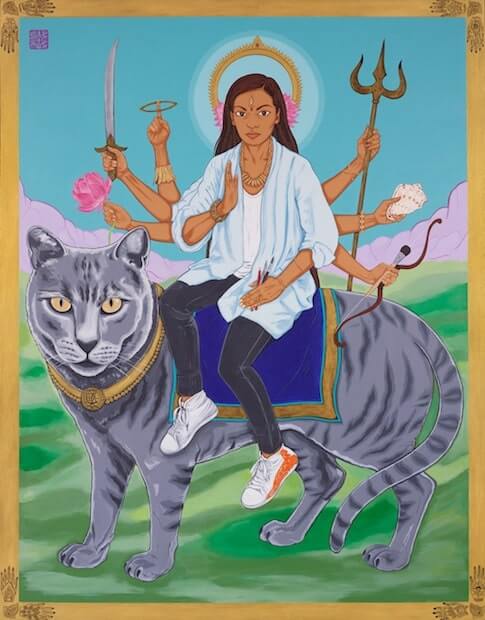For this year’s Archibald Prize, artist Kate Beynon painted Sangeeta Sandrasegar as a contemporary embodiment of the goddess Durga

There’s Cate Blanchett, Nick Cave, Adam Goodes, Missy Higgins, Barry Humphries… and someone who could be a modern version of Mahadevi Durga.
Melbourne artist Kate Beynon’s portrait of fellow artist Sangeeta Sandrasegar, in an unusual avatar of the Indian goddessDurga, has made it to the shortlist of this year’s Archibald Prize.
In a candid conversation, the duo tell us about their nominated work, their diverse origins and their fascination with the powerful Hindu goddess.
Kate’s painting, aptly titled Sangeeta and Fuji, is a hybrid characterisation of womanhood, with Sangeeta sitting on a giant cat, posing as the warrior goddess, Durga. She is holding contemporary objects and tools in her hand, like an artist’s scalpel, a pencil and paint brushes.
“I wanted to paint Sangeeta the artist, but inspired by the Hindu goddess Durga,” Kate told Indian Link. “The goddess represents a strong, feminine, creative energy with a protective force. I wanted to show Sangeeta’s cult gold jewellery and sneaker passion, combined with Durga’s traditional objects like the sword, the trident, with Sangeeta’s own artistry tools. Instead of the tiger I morphed Fujimoto, Sangeeta’s pet cat, to be her guardian creature”.
Kate’s fascination with the Hindu warrior goddess started in 2012 during her first trip to India with Sangeeta.
“I loved the portrayal of Durga that I saw there. I saw references of the goddess in Sangeeta’s work too. I researched about the goddess, her different forms, the objects she carried and their significance in the Hindu culture”.
Sangeeta and Fuji is a perfect example of a collaboration between two artists from multicultural backgrounds, illustrating a global, cross-cultural art form. Sangeeta’s own work consolidates post-colonial and hybrid cultures, exploring her context within Australia and its relationship to migrant communities. Her work interprets and represents shifts in overlapping cultural structures – sexuality, race and identity, in contemporary societies.
“Kate’s painting at this year’s Archibald is a mythical and alternative characterisation of myself,” Sangeeta revealed. “It draws out my Indian heritage combined with Chinese symbols. The contemporary jewellery I wear, and the way I hold in my hand upright in front of my chest symbolising the Chinese gesture of greeting, both portray a sharp contrast to the conventional images of the Hindu deity”.
In traditional iconography, Durga is depicted as standing on a lion in a fearless pose of Abhay Mudra, that is, freedom from fear. Here though, for ‘Goddess Sangeeta’, it is the powers of creative energy – and those of cultural assimilation – that are paramount.
The artist duo identify with everything multicultural and hybrid. Born in Hong Kong in 1970, Kate migrated from the UK with her family in 1974 and has Chinese-Welsh parents, while Sangeeta has Indian-Australian and Malaysian roots.
Both women embrace their mixed cultures and manifest the different aspects of it through their splendid works of art.
This is the sixth time Kate has been a finalist at the Archibald. The Archibald Prize is awarded annually to the best portrait of a person distinguished in art, letters, science or politics, painted by an artist resident in Australasia.
Named after JF Archibald, a journalist and founder of the Bulletin magazine, who also served as a trustee of the Art Gallery of NSW, the Archibald Prize was first awarded in 1921. An open competition judged by the trustees of the Art Gallery of NSW, the finalists exhibit their work at the Art Gallery and several pieces are now part of the Gallery’s collection.
Over the years some of Australia’s most prominent artists have entered the competition, and the subjects have been equally distinguished in their fields.
The 2014 Archibald Prize went to Fiona Lowry for her stark portrait of architect Penelope Seidler. This year’s exhibition featured 54 portraits, alongside 39 works selected for the Wynne Prize and 35 works for the Sulman Prize.

acrylic on linen
© Kate Beynon
The Archibald, Wynne and Sulman prizes will be exhibited at the Art Gallery of NSW from July 19 to September 28.



